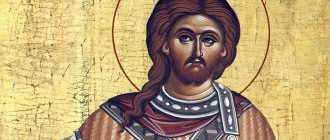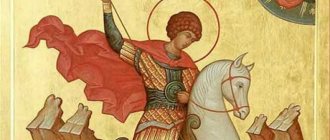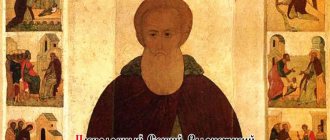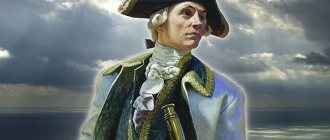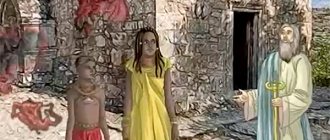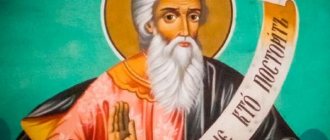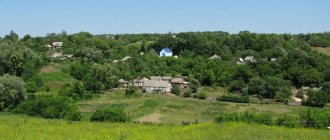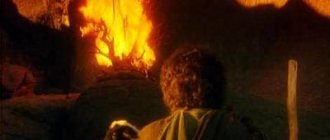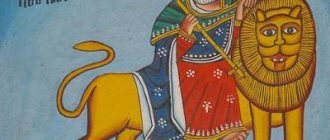In general, if your path is set in the direction of these villages, then plan a visit to the monastery of St. Mines. Although which one is more important to visit is a controversial issue. Many people go to the monastery purposefully, and then decide whether to visit Lefkara or not. Let's first tell you a little about Mina, in whose honor the monastery is named.
Saint Mina
Mina of Cotuan (Phrygian) is a Christian saint, revered among the great martyrs. It is known that Mina (pronounced Minas in Greek) was born in Egypt in the 3rd century AD. and adopted Christianity at an early age. Mina subsequently became an officer in the Roman army and served in the cavalry legion in the city of Cotuan in Phrygia (a region in western Asia Minor). Apparently this is why Mina is often depicted on icons as a warrior, almost always on horseback. When the persecution of Christians began, Mina left his service and became a hermit. Years later, deciding that he was ready to sacrifice himself for the sake of faith, he returned to the city, where he publicly declared himself a Christian. He was immediately captured and subsequently martyred. This was at the end of the 3rd century under Emperor Maximilian.
His body was brought to Egypt. At Karm Abu Mena (west of Alexandria) a tomb was built, then a basilica and a shelter for numerous pilgrims, which were later destroyed by the Arabs. The monastery church houses a particle of the relics of St. Mina, who became famous for his numerous miracles. The celebration of the memory of St. Mina in the monastery takes place on November 11. On this day, many people flock here from all over Cyprus.
History of transformation
The date of foundation of the monastery of St. Mina (Minas in Greek transcription) is not precisely known. The first mention of it is contained in a document of 1562 - the Paris Code. It says that the monastery was founded in the 12th century. The first reliable notes about the life of the monastery were left in 1608-1610 on the Venetian edition of the Gospel of 1606, reverently kept by the monastery brethren for many years.
The life of the brethren at that time was not easy, and the monastery was poor and small. Few of the inhabitants of that time were engaged in oil production, primitive crafts, in order to survive. Archival materials contain detailed lists of agricultural tools and church utensils of that time. Over the next century and a half, the monastery was intensively built. The main monastery church was built on an old foundation, which clearly symbolizes the continuity of Orthodox traditions.
The temple experienced a long period of neglect since the Ottoman rule. In the middle of the last century, the caring hands of new residents brought the monastery back from oblivion; she found a second life - she became a woman.
The sisters made enormous efforts to repair the temple, restore the monastery premises, and make them suitable for living. The territory of the monastery was turned by hardworking nuns into a kind of Garden of Eden.
History of the monastery of St. Mines
The exact date of the foundation of the monastery is not known for certain. According to some sources, it was founded by the Catholic monastic Order of the Dominicans in the 13th century, at the end of the reign of the Lusignans. In others, it is believed that the monastery already existed in late Byzantine times. The first written mention of it dates back to 1606.
Greek sources of the 16th - 17th centuries report that the inhabitants of the village of Vavla, which is located not far from the monastery, long before the founding of the monastery, worshiped the Blessed Virgin Mary at this place. A cave with a sacred spring in the monastery garden tells us about those times. True, the source itself has already dried up, but the place where it once bubbled up remains.
Like many monasteries in Cyprus, the monastery of St. Mina has been devastated many times throughout its history. In 1734, the Russian pilgrim Grigorovich-Barsky visited here, whom we have already mentioned several times. “This monastery is small and poor and has few monks,” he wrote in his memoirs. Only twenty years later, through the efforts of Abbot Parthenius, the former Catholic monastery was revived as Orthodox. During its heyday, there were up to 45 monks in the monastery.
The architecture of the monastery is a mixture of Byzantine and Gothic styles. The church's paintings date back to 1757. The creation of the iconostasis, restored in 2004, dates back to the same time. On the northern and southern walls of the temple frescoes of St. George and St. Mines, brushes of the famous Cypriot icon painter Philaret.
In the first half of the 20th century, the monastery fell into complete disrepair. Only in 1965 did the monks, or rather nuns, return here again, having moved here from the monastery of St. George Alamanu. Since then, the monastery has become a women's monastery.
MINE
The early iconography of M. is represented by monuments of the 5th-7th centuries, associated in origin with the pilgrimage center of Abu Mina in Maryut. These primarily include a group of ampoules - flat terracotta vessels with a rounded body, a narrow neck and 2 handles, intended as eulogy for pilgrims. On the front side of the ampoule (sometimes on both sides) there is a relief image of M. pressed out with a stamp. The mass production of these pilgrimage shrines implied the standardization of the iconography of the saint (the classification of M. ampoules was proposed, in particular, in the works of Kaufmann CM Zur Ikonographie der Menas-ampullen. Cairo, 1910. P. 62; Witt J. Die Menasampullen. Wiesbaden, 2000. P. 33-61. (Werke der Alltagskultur; 1); Gilli M. Le ampolle di S. Mena conservate negli Staatliche Museen di Berlino // Antiquité Tardive. P., 2002. N 10. P. 461-468). The main type of iconography was the frontal image of M. in full height, with his hands raised in prayer, that is, in the pose of an orant; rarely the head is shown in a spread (see, for example: Leclerq. 1907. Col. 1725. Fig. 449). The surviving material from this time, and in addition to the ampoules, this includes carved reliefs, allows us to talk about the variability of the image of the saint within a given type of orant iconography. The most common image can be considered the image of M. - a beardless young man with curly hair, in a short, knee-length, belted tunic, in a long cloak, fastened with a fibula and thrown over his shoulder or lying on his back, in boots or sandals with leggings. This composition of clothing characterizes the saint as a warrior (for example, images of M. on a pyxide, 6th century, British Museum, London, on the cloak there is a tavlion; on an ampoule, 6th century, Louvre, Paris, elements of armor are visible on the tunic). A variant of this version are images of M. in a long chiton, sometimes with ornamented elements reminiscent of the military dignity of the saint (for example, on an ivory carved icon, 2nd half of the 7th century, City Collection of Applied Art, Castello Sforzesco, Milan - see: Weitzmann. 1979. Cat. 517. P. 578). The image of M. oranthus, shown in old age, on an ampoule of the 7th century stands out. (Louvre, Paris; on the back of St. Thecla) - the image is rather schematic, of mediocre workmanship, nevertheless, a wedge-shaped beard is visible, the saint is dressed in a long tunic with short sleeves; an inscription with the name has been preserved: “ευλογια του αγι(ου) Μηνα αμη(ν)” (see: Ibid. Cat. 516. P. 576-578 - attributed with a question mark).
Sschmch. Vikenty, martyr. Mina and martyr. Victor. Miniature from Minology. 1063 (Sinait. gr. 500. Fol. 129v) Sschmch. Vikenty, martyr. Mina and martyr. Victor. Miniature from Minology. 1063 (Sinait. gr. 500. Fol. 129v)
The image of M.-orant is presented in one of the most common compositions in the iconography of the saint, with two camels flanking his figure. Publication of Copt. manuscripts of the 9th century. with the text Encomia in honor of M. (NY Morgan. 590; facsimile and translation in English: Dresher. 1946. P. 141-142) served as the starting point for a discussion about the content and origins of this iconography (see, for example. : Dresher J. St. Menas' Camels Once More // BSAC. 1941. T. 7. P. 19-32; Gilli M. Le ampolle di S. Mena: Religiosità, cultura materiale e sistema produttivo. R., 2002. P. 15-16). Its explanation had already become relevant by the time the said manuscript was created, since it not only tells the story of the composition of the first image of the saint, but also sets out the version of the origin of the composition. Thus, the military leader Athanasius created an image of M. in memory of the rescue of the ship, when sea monsters with camel heads that attacked the ship were driven away by fire emanating from the body of the saint. martyr, and they reverently bowed before him: “...he made a wooden tablet and depicted on it the image of Saint Apa Mina. He also depicted under his feet the likeness of animals that he saw in the sea, similar to camels worshiping him (the saint)” (Dresher. 1946. P. 142). The inclusion of this story in the Encomium is due to the uniqueness of the iconography and in the text itself is explained by the need to reject doubts about the ignoble origin of the saint that arise when looking at his image: “Nowadays, when people ignorant of this see an image made by a faithful man (Athanasius), they think that the animals are camels, so some dare to say about this great lamp (M.) that he was a shepherd” (Ibidem). However, Encomia also mentions another miracle that marked the beginning of life. the famous tomb of the saint: camels carrying St. M.'s relics, refused to move further, which became a sign from above to indicate his resting place. Here Athanasius built a tomb and left the first icon of the saint at this place, and took the same one with him, having consecrated it on the relics. Due to the recognition of the image, the attribution of the image of M. with 2 camels bowing before him does not present any difficulties, including in the absence of a signature (on the ampoules there is often an inscription on the sides of the saint’s halo: “ο αγιος Μηνας”); one of the closest early iconographic analogies is the image of the prophet. Daniel in the lion's den. One of the earliest examples of the composition of M. with a pair of camels at his feet is considered to be a relief of the 5th century. from the Greco-Roman Museum in Alexandria, in which the figures are presented on a smooth background (see: Weitzmann. 1979. Cat. 512. P. 573-574). An Arab mentions a sculpture of M. at his tomb. geographer who compiled in the 11th century. description of the Abu Mina complex: “On one side of the church (in the name of M.) there is a huge marble tombstone with two camels, above them rises a statue of a man whose legs rest on camels” (see: Quatremère E. Memoires géographiques et historiques sur l 'Egypte et sur quelques contrées voisines. P., 1811; text reproduction: Leclerq. 1932. Col. 346).
There is another type of this composition, the details of which emphasize its correlation with the pilgrimage center of Abu Mina. So, for example, on the mentioned ivory-carved icon, 2nd floor. VII century (City Collection of Applied Art. Castello Sforzesco, Milan) M. is shown against the background of a ciborium, adjacent to which are 2 symmetrical volumes, crowned with domes, with crosses on them; in the opening of each, between the curtains, hangs a lamp, the lower part is covered with an openwork lattice; at the feet of the saint there are camels, which are here elements of sacred topography, since, having stopped on the way, they indicated the resting place of M.’s relics; on the upper field there is an inscription with the name of the saint. Also against the background of a ciborium with curtains, complemented by architectural details, but without camels, M. is presented on a carved ivory plate of the 7th century. (Museum of the Middle Ages, Paris). Under the shadow of the architectural ciborium, with camels at his feet, M. is depicted on a relief from the Kunsthistorisches Museum in Vienna (between the 6th and 7th centuries); Smaller-scale figures of 2 men in long robes, apparently pilgrims, located to the left and right of the figure of the saint, were introduced into the usual iconography; the inner surface of M.'s cloak is decorated with numerous small crosses (see: Aurea Roma: Dalla città pagana alla città Cristiana / A cura di S. Ensoli, E. La Rocca. R., 2000. P. 602. N. 302; Redigolo. 2011/2012. Tav. III b. P. 129). Under the ciborium, the figure of the saint with camels at his feet is also represented on a pyxid of the 6th century. (British Museum, London); this image is the central part of the relief composition on the vessel, which also includes a scene of the martyrdom of the saint. Facing the M.-orant on the sides of the ciborium are figures of men in military clothing, like the saint’s, praying to him, and 3 women. The earliest known martyrdom scene includes depictions of the sentencing of Rome. prefect and execution: the warrior grabbed M. with one hand (placed on his knee, hands tied behind his back, naked, with a bandage on his hips) by the hair, and with the other raised a sword over him, next to him was an angel flying from heaven with covered hands, ready to accept the soul of the martyr . On the ampoules in compositions with the M.-orant and bowing camels there are symmetrical images of equal-ended crosses on the sides of the saint’s head. These crosses may represent a variant of an abbreviated designation of the architecture of a place of pilgrimage (for example, ampoules of the 7th century, State Historical Museum - see: Zhuravlev. 2012. Fig. 1 on p. 92).
Mch. Victor, martyr. Mina and sschmch. Vikenty. Icon. X century (Metropolis of China, Cyprus)
Mch. Victor, martyr. Mina and sschmch. Vikenty. Icon. X century (Metropolis of China, Cyprus)
On the body is traditional. The ampules also included the main image of the saint in profile - his description retains the features of a young beardless man with short, distinctly curly hair (see: Leclerq. 1907. Col. 1728. Fig. 450); rarely - full-face shoulder (see: Idem. 1932. Fig. 7981).
M.'s status as a warrior determined his image in tandem with another most revered saint. warrior George the Victorious. M.-orant with camels at his feet and an equestrian martyr. George slaying the serpent are represented on 2 halves of a bronze medallion found in the Radiant burial ground (with grave goods from the 1st half of the 7th century; see: Aibabin A.I. Chronology of Crimean burial grounds of late Roman and early medieval times // MAIET. 1990 Issue 1, pp. 68, 69. Fig. 55. 2, 3). This medallion, with a diameter of approx. 2 cm, could also be a travel icon. In the early period, the image of a M. warrior on a horse was also placed on ampoules, but it was fundamentally different from tradition. depictions of an equestrian warrior in that the saint retained the prayerful position of his hands in the gesture of oration (see: Leclerq. 1907. Fig. 451; 1932. Fig. 7982, 7983). After Arab. During the conquest, the image of a M. warrior on horseback became widespread among the Copts, including due to the description of posthumous miracles, in which the saint appears in the form of an armed horseman. This is how he is presented in miniature in Copt. manuscripts of the 9th century. (?) (The J. Rylands Lib., Manchester. Copt. S. 33; see: Walter. 2003. Pl. 56). M. is depicted as a horseman in a flowing cloak with a spear pointing downward and a shield on a sheet miniature in a Nubian manuscript of the 9th-10th centuries. (Lond. Brit. Lib. Orient. 6805. Fol. 10a - see: Budge. 1909. P. 19). Three crowns are depicted above the saint’s head, which is probably a reflection of an episode from the Copts. Encomia, in which the saint was promised 3 crowns: for virginity, asceticism and martyrdom; below is an unidentified figure of a man touching a horse's hoof. Also, with 3 crowns, M. the warrior on horseback is represented on the fresco of the 7th-8th centuries. to Egypt mon-re Bauite: the 1st crown is presented to the saint by an angel flying to him, the 2nd is already adorning his head, the 3rd crown M. holds in his hand (see: Wilber. 1940. Fig. 10).
Vmch. Mine. Fresco of the catholicon of the Hosios Loukas monastery. 30–40s XI century
Vmch. Mine. Fresco of the catholicon of the Hosios Loukas monastery. 30–40s XI century
In Copt. The earliest fresco images of M., dating from the 7th to 9th centuries, have been preserved in the paintings of Egyptian temples. (Bauit, Abu Girge, Kelley, Tebtinis). In the church consecrated in the name of M. (formerly the temple of Ramesses II) in the ancient complex of Medinet Habu in Luxor between the 7th and 8th centuries. an ensemble was created, including a cycle of images of the saint associated with his miracles (see: Ibid. Fig. 1 - graphic reconstruction; Fig. 2 - color copy). In the north-east corner of the temple along with surviving fragments of inscriptions in Greek. language with the name M. (see: Ibid. Fig. 3) there are 4 scenes in which the saint is shown as a young, beardless man with short reddish hair; He wears a medium-length belted tunic and cloak. The cycle opens with an image of M.-orant, to the left and right of the figure of the saint - of different heights of the building. This is followed by a scene depicting the “miracle of the promised camels” (for a description of the miracle according to the Coptic RKP, see: Dresher. 1946. R. 110-111): M. is addressed to a man holding a pair of camels by the reins; behind her is an equestrian image of a saint with his left hand raised. Then, as follows from the inscription, the scene of the resurrection of the murdered pilgrim - M. touches the shoulder of the resurrected one, as if presenting it as evidence of an atrocity to the murderer standing right there, on the right (see: Ibid. R. 111-114). The cycle is completed by figures identified by the inscription as Elizabeth and her daughter, apparently patrons of the temple (in particular, its paintings).
At the end of the iconoclastic period, M.'s iconography underwent dramatic changes. The image of a young martyr-warrior (in Coptic art this tradition continued to exist for a long time, see, for example, on the fresco of the monastery of St. Anthony, 1232/33; Bolman. 2002) is replaced by the image of a middle-aged or older husband, with graying curly short hair and a short rounded beard; in his military clothes, thanks to the tavlion on the cloak, his Byzantine affiliation is emphasized. court circle. However, in this case we should not talk about the transformation of the image, but, as N.V. Gerasimenko showed, rather about a parallel and independent of Egypt. tradition of the formation of the “Constantinople” version of M. iconography, caused by the general process of revision of the Lives of the saints and the formation of their iconography after the victory of icon veneration (Gerasimenko. 2008. P. 106). One of the early images of the “Constantinople” tradition is presented on the capital’s work of a carved ivory triptych icon with the Deesis and saints (X-XI centuries, Vatican Museums), where M. is depicted on the right wing in the middle row, shoulder-length, dressed in a cloak with tavlion; the paired image on the left wing is that of a military commander. Mercury; see: The Glory of Byzantium: Art and Culture of the Middle Byzantine Era, AD 843-1261: [Cat.] / Ed. H. C. Evans, W. D. Wixom. NY, 1997; Cat. 79. P. 131-132). 2 icons with a central image of the arch. Michael, located in the treasury of the Basilica of San Marco. On both, the image of M., due to its compositional arrangement, has an important meaning (the saint is clearly recognizable in the “Constantinople” interpretation of the appearance; the inscription with the name is preserved). On the icon XI - beginning XII century with the tall figure of arch. Michael, an enamel medallion with a waist-length image of M. holding a cross in his hand is placed on the upper field in a kind of 3-figure Deesis and is paired with a medallion with the image of St. Peter (see: Il tesoro di San Marco. 1971. P. 23-25. N. 16). On the second, 2-sided icon (1st half of the 11th century) with a half-length image of arch. Michael, a chased medallion with a shoulder-shaped image of M. is placed on the reverse, in the middle, at the base of the cross; in the middle cross and at the ends of the branches there are images of saints (see: Ibid. P. 25-27. N. 17). The rapid spread of the capital's version of M.'s iconography is evidenced by the fact that his image was willingly included in the painting of Cappadocian temples (for example, in Yylanly-kilis (“Snake Church”), late 9th - 1st half of 10th centuries, in Kubbeli -kilise No. 3 in the Soganly valley, late 10th - early 11th centuries, Karabash-kilise, 1060/61, and many others).
Vmch. Mine. Fresco c. St. Nikolai Kasnitsis in Kastoria. 2nd half XII century
Vmch. Mine. Fresco c. St. Nikolai Kasnitsis in Kastoria. 2nd half XII century
Using the example of obverse Minaia manuscripts, where the image of each saint is fixed under the corresponding day of remembrance, it becomes especially obvious not only the distinction between 2 saints with the name Mina - M. and Martyr. Mines of Alexandria (Kallikelad), but also specific features of the iconography of the saint emerge; There, in the menaions, its joint image with the sschmch is determined. Vincent of Augustopolis and the martyrs Victor and Stefanida of Damascus, whose memory also falls on November 11, but their Lives are in no way connected. So, in Minology imp. Basil II (Vat. gr. 1613. P. 174, 1st quarter of the 11th century) presents the scene of the martyrdom of M., Victor, Vincent and Stefanida; M., the executioner raised his sword over the Crimea, is shown as a medieval man, short curly hair with graying hair, a short beard has a rounded shape; he is dressed in a long chiton of gray-blue tone. The same characteristic is given to the saint in the miniature in the Minology from the VMC monastery. Catherine in Sinai (Sinait. gr. 500. Fol. 129v, 1063), where he occupies a place of honor in the center, between the standing frontal tall schmch. Vincent and martyr. Victor; M.'s clothing consists of a tunic and a cloak with a tavlion fastened with a fibula on the shoulder (according to the same minain principle, the saints are presented together, for example, in miniatures in the minology of the Service Gospel (Vat. gr. 1156. Fol. 266v, 3rd quarter of the 11th century. ) and in the Greek-Georgian manuscript of the late 15th century (RNB. OI 58. L. 86 vol. - M. stands first; on L. 54 vol. - a mantle image in a medallion among other most revered martyrs); in the painting temples, for example in Kubbeli-kilis No. 3 in Soganly, 1st half of the 10th century; in New Tokali-kilis in Goreme (50s or 60s of the 10th century); in the Varvara church in Soganly, between 1006 and 1021; in the Church of George Diasorita on the island of Naxos, 11th century; in the Church of Martorana in Palermo on the island of Sicily, 1143; in the Cathedral in Montreal, in the same place, 1180 -1190; in the Church of St. Andrew in Livadi on the island of Kythira, 13th century; in the Church of Nikolai Orphanos in Thessaloniki, 1309-1319; in the Church of the Ascension of Decani Monastery, 1348-1350 .; in the Church of the Holy Trinity of the Cozia Monastery, Romania, about 1386, etc.
Vmch. Mine. Fresco c. Nicholas Orphanos in Thessalonica. OK. 1320
Vmch. Mine. Fresco c. Nicholas Orphanos in Thessalonica. OK. 1320
On a miniature from a manuscript of the Monastery of the VMC. Catherine on Sinai presents a specific feature of the iconography of the saint, which will become a kind of marker for images of the saint in the post-iconoclastic period: in his left hand M. holds a cross, in the center of which the shoulder-shaped image of the Savior is imprinted (on the problems of attribution of such an image, see: Gerasimenko. 2008; Redigolo. 2011/2012); a variant of this iconography is a medallion with the image of the Savior at the level of the saint’s chest. One of the earliest such examples can be seen on a Cypriot icon of the 10th century. (Metropolis of China; see: Sophocleous S. Icons of Cyprus 7th - 20th Cent. Nicosia, 1994. P. 124), the composition diagram on it is similar to the image in the miniature in the Minology from the Sinai Monastery with the difference that M. is shown holding in front of him, like a shield, the image of Christ Pantocrator. The source of the appearance of the image of Jesus Christ in M.’s iconography was apparently the episode of the Savior’s visit to the saint in prison. This appearance and the dialogue between Christ and the martyr are described in detail in the Copt. and Arab. versions of Martyrdom. M. receives many for fulfilling God’s command. promises (including the construction of his tomb, the remission of sins of all who come to his tomb with prayer, that the martyrdom (battle) will last 20 days) (NY Morgan. 590. Fol. 13v - 14v; retelling in English, see: Drescher, 1946, pp. 98-99). In the version of M.’s iconography with the image of the Savior, the technique of comparing images, accepted in Byzantine art, is used, when “the function of the central character is “revealed” through his correlation with another, higher in status” (Butyrsky. 2002).
The image of the saint on the fresco in the c. St. Nicholas Kasnitsis in Kastoria (2nd half of the 12th century) seems to summarize the iconography of the saint, preserving in it the most significant features of the images of the early and middle Byzantines. time: M. (half-length image) is shown as an orant with hands raised in prayer, and on his chest in a medallion resembling a sphere is Christ Pantocrator; M. is gray-haired, with short curly hair and a short rounded beard (see: Χατζηδακης Μ., Πελεκανιδης Σ. Καστορια: Ψηφιδωτα, τοιχο γραφιες. Αθηνα, 1992. Σ. 58. Εικ. 10); also represented in Greco-cargo. manuscripts (RNB. OI 58. L. 86 vol.).
Thus, in the iconography of M. of the Middle Byzantine period, three variants of the image can be distinguished. With a cross: on the fresco c. Panagia Arakos near Lagoudera, Cyprus (1192); on the mosaic of the cathedral of the Nea Moni monastery on the island of Chios (1042-1056); on the mosaic of the monastery of Chora (Kakhrie-jami) in K-pol (c. 1316-1321), etc. With a cross and an image of the Savior: to the south. bronze gates of St. Clement of the Basilica of San Marco in Venice (Porta di San Clemente, K-pol, c. 1110-1120) - a cross in his right hand, a medallion with the image of Christ is held with his cloak-covered left hand; fresco in the north-west chapel of the katholikon of the Hosios Loukas monastery (30s - 40s of the 11th century) and in the church. Ascension in Mileshevo (c. 1234) - M. holds a cross with the image of Christ in his right hand, the left one in front of the chest is open in prayer with the palm outward. With the image of Christ directly on the tavlion - in the c. Holy Trinity in Sopočani monastery (1263-1268); with an image sewn in the form of a medallion (tavlion) onto the cloak, along the edge of the medallion, as on the hem of the cloak, imitation pearl hem - in c. St. Nicholas Orphanos in Thessalonica (c. 1320); in c. Dormition of the Most Holy Our Lady of Gračanica monastery (c. 1320) - on the tavlion, etc.
From the 13th century Images of M. in military armor, with a sword and shield are becoming widespread (for example, in the Church of the Holy Apostles in the Peć Patriarchate, c. 1290; in the Pantocrator Monastery in Decani, 1348-1350), which is explained by the general nature of development Byzantine painting and the meaning that St. acquired by this time. warriors.
Vmch. Mine. Painting of the church of the monastery of the Great Martyr. Mines in Lefkara, Cyprus. XIX century
Vmch. Mine. Painting of the church of the monastery of the Great Martyr. Mines in Lefkara, Cyprus. XIX century
The scene of the beheading of the head of M. in addition to Minology imp. Basil II is included in the images of the Minology of the despot Demetrius Palaiologos (Bodl. gr. theol. f. 1. Fol. 16v, 1322-1340, Thessalonica). In the wall menaions this scene is represented in the frescoes of the narthex c. St. Apostles in the Patriarchate of Pecs (1561).
In the post-Byzantine period. paintings continued to coexist in parallel with “martyr” and “military” versions of M.’s iconography. In a chiton and cloak (sometimes a shirt with short sleeves, decorated with a golden mantle, is worn over the chiton), with a cross in his hand, M. is represented in the paintings of c. Vmch. George of the Kremikovsky Monastery, Bulgaria (1493), catholicon of the Dionysiatus Monastery on Mount Athos (1546), c. Dormition of the Most Holy Virgin Mary in Kalambaka (XVI century), c. Transfiguration in Klimatiye (Veltsist) (1568), galleries of the monastery of St. John the Baptist in Serres (Ceres; 1630); c. Nativity of Christ in Arbanasi, Bulgaria (1681), as well as on the icons - “Christ the Great Bishop, with the Saints” (mid-16th century, Pantocrator Monastery on Athos); “Saints Mina, Vincent, Victor” (early 17th century, Hilandar monastery on Mount Athos); “Saints Mina, Vincent, Victor” (mid-18th century, Museum of the Vlatadon Monastery, Thessalonica), etc.
In military armor, with a spear, sword and shield, he is depicted in the paintings of Mon-Rei Philantropinon (1531/1532) and Diliu (1543) on the island of Lake. Pamvotida (Ioannina), Stavronikita Monastery on Mount Athos (1546), c. St. Demetrius in Imathia (1570), Romanians. Mont-Rei Moldovitsa (1532-1537), Voronets (1547-1550) and Khurezi (1694); on the icon - “Saints Mina, Vincent, Victor”, con. XVI century (Museum of Paul and Alexandra Kanellopoulos, Athens), etc.
Single images of M. in icon painting are rare, for example, on the icon from the Hilandar monastery (c. 1700) he is represented in a chiton and himation, probably with a sword in his hands (the image is partially lost).
Vmch. Mine. Fresco of St. Sophia Cathedral in Kyiv. 40s XI century
Vmch. Mine. Fresco of St. Sophia Cathedral in Kyiv. 40s XI century
In the post-Byzantine period. painting, the type of equestrian depiction of M. is being revived, for example. on a Cretan icon c. 1500 (Museum of Icons, Recklinghausen; see: Benchev. I. Icons of patron saints. M., 2007. P. 362), icon of the 17th century. master Stylianos of Crete (Temple Gallery), icon 1st half. XVII century Cretan master Jeremiah, an icon of the 18th century. (Byzantine Museum, Thessalonica). The equestrian image of M. with the image of the Savior on his chest (19th century) is a revered image in the Cyprus monastery in the name of St. Mines in Lefkara. M. on horseback is presented in a copper engraving, ser. XIX century from the Simonopetra Monastery on Mount Athos.
A unique example of the image of M. in military garb, sitting on a wooden throne, is presented in the painting of 1619/20. Temple of M. in Monodendri, Greece. In the post-Byzantine era. period there are rare hagiographic icons of M., for example. an image of a saint with 6 scenes from the Life of the icon painter E. Lambardos: in the centerpiece the great martyr is depicted full-length, in military equipment (1st third of the 17th century, Museum of the Greek Institute of Byzantine and Post-Byzantine Research, Venice). Draw the 1st floor. XIX century M. in the form of an old man with a small pointed beard and long mustache; he is represented from the waist up, in rich armor, decorated with a mask on the right sleeve (collection of A. Makris and H. Margaritis). The temple icon of M. is located in the church consecrated in his honor in Thessalonica. The description of the saint's appearance is included in the Greek. a manual for icon painters - Hieronymus Erminius. Dionysius Furnoagrafiot (c. 1730-1733). In Sect. “Holy Martyrs” about his individual image it is said: “Mina the Egyptian, an old man with a round beard” (Erminia DF. P. 163. No. 9); the same characteristic is retained in Sect. “How the suffering of the martyrs is depicted in every month of the whole year”: “Saints Mina, Victor and Vincent died in different torments. Mina is an old man with a round beard, Victor and Vikenty are young” (Ibid. P. 203, under November 11).
In Rus', the image of M. first appears in the Cathedral of St. Sophia of Kyiv (40s of the 11th century): his half-length image in a rectangular frame (paired image - Martyr Victor) is presented in the vault of the south. arches in the west internal gallery; the characteristics of the image correspond to the images of the con. X - gray XI century, the saint is dressed in a tunic and himation, holding a cross in his right hand. Given in Russian In the iconographic originals of the consolidated edition (18th century), the characteristics of the saint’s appearance do not allow him to be distinguished from the martyr. Mines of Alexandria (Kallikelad) (see in the article Mina, Ermogen and Evgraf). Thus, the appearance of both saints is usually likened to the appearance of St. Nicholas the Wonderworker, both of them are prescribed by the originals to be depicted as warriors (M.: “A warrior, gray-haired in the likeness, hair disheveled, brada like Nikolin, small temples behind the ears, sankir robe with whitewash, cinnabar underside, in hand a cross and a spear, and in the other, a sword in a sheath, leggings, a gaff. In other originals he writes: curly hair" - Filimonov. Iconographic original. pp. 189-190).
Vmch. Mine. Carved icon. XVII–XIX centuries (CMiAR)
Vmch. Mine. Carved icon. XVII–XIX centuries (CMiAR)
The image of M. is often included in the selection of saints surrounding the mantle image of St. Nicholas, for example. in the middle of the icon “St. Nicholas, with selected saints" from the Myronositsa Church. in Vladimir (late 15th-16th centuries. GVSMZ - in a red chiton and ocher himation); on the icons “St. Nicholas, with the Deesis and selected saints" (beginning of the 16th century, GMZRK, comes from the Church of Our Lady "Hodegetria" in Rostov; 1st half of the 16th century, State Russian Museum - M., gray-haired old man with a short beard, dressed in tunic and himation, with a cross in hand (see: St. Nicholas of Myra. 2006. Cat. No. 27. P. 94-95)).
The image of M. in a blue tunic with a patch on the sleeve, in a red himation is one of the saints coming to the Savior, depicted on the side door of the iconostasis with a military theme (“Miracle of Martyr George about the serpent”, “St. Nikita slaying the demon”; beginning. XVI century; comes from the Church of Saints Mina, Victor and Vincent in Tver, see: Ibid. Cat. No. 25. pp. 90-91).
M. received special veneration in the Russian North. Images of the saint in a tunic and himation, as a man of mature age, often with gray hair and beard, with a cross in his hand, have been preserved on a number of icons, where he is represented in the margins among other saints. A half-figure of a saint with a short beard, with gray hair and beard, with a cross in his hand, is placed on the lower field of the icon “The Position of the Robe of the Mother of God, with the Deesis and Selected Saints” from the Nativity Cathedral in Kargopol (1st half of the 16th century, VGIAHMZ) ; on the lower field of the icon “Our Lady Hodegetria, with selected saints” from c. Savior on Valushki in Kargopol (2nd quarter of the 16th century), “Our Lady Hodegetria, with the Holy Trinity and selected saints” from the Leontievskaya Church. in Vologda (2nd quarter of the mid-16th century) - everywhere in a green tunic and a red cloak (or dark pink).
Among St. warriors and princes M. - a gray-haired old man with a short, curly beard and disheveled hair; he is depicted full-length in full military garb, with a spear, sword, bow and shield on the Vologda double-row icon from the Entrance to Jerusalem Church. Kargopol (late 16th-17th centuries, VGIAHMZ). Among St. warriors - on the folding door of the 17th century. with the image of St. Alexander Svirsky in the middle (Museum of Icons, Recklinghausen - see: Benchev. 2008. P. 285). As a warrior, with a spear and shield, he is represented in the paintings of the Cathedral of the Nativity of the Most Holy. Theotokos Ferapontov monastery (1502, master Dionysius with his sons), in the southwest. pillar of the Spaso-Preobrazhensky Cathedral of the Spassky Monastery in Yaroslavl (1564), in the c. Dormition of the Most Holy Mother of God in Sviyazhsk (late 16th century), to the south. north-east border pillar of the Cathedral of the Smolensk Novodevichy Monastery in Moscow (late 16th century), in the north-east. pillar of the Assumption Cathedral of the Moscow Kremlin (1642-1643), in the c. Resurrection in Rostov (1670-1680), in the Trinity Cathedral of the Ipatievsky Monastery in Kostroma (1684; together with the martyr Savva Stratelates), etc.
Vmch. Mina, with scenes from the Life. Icon. 2nd quarter - mid. XVI century (CMiAR)
Vmch. Mina, with scenes from the Life. Icon. 2nd quarter - mid. XVI century (CMiAR)
From the 2nd half. XVI century in Russian in art there are hagiographic icons of M. One of them, “The Great Martyr Mina in the Life” (2nd half of the 16th century, CherMO) comes from the Resurrection Goritsky Monastery (see: Rybakov A. Vologda Icon: Centers of Artistic Culture of the Earth Vologda XIII-XVIII centuries. M., 1995. No. 43/44). Stamps: 1. Bringing relics to the fatherland; 2, 3. The miracle of the salvation of the strangled merchant; 4, 5. The miracle of Eutropius, who promised to deliver a dish to the church of Mina; 6. The miracle of the salvation of a woman named Sophia from a warrior; 7. Miracle of the healing of the lame and dumb; 8. Miracle of the Samaritan woman Athrace, saved from death and converted to faith; 9. Miracle of the conversion of a Greek; 10, 11. Miracle about a Jew and a Christian; 12. Miracle of the rich Greek and the poor widow; 13. The miracle of the promised camels; 14. Miracle of donated firewood; 15. Miracle of the healing of a demoniac; 16. The miracle of the boar that stole. Contents 15 hallmarks of the hagiographic icon of M. (in the middle - in military armor, with a spear and sword) from a wooden church in the name of the saint, which stood on the site of the Intercession Church. in the village Danilov, Konakovsky district, Tver region. (mid-16th century, TsMiAR), focused on scenes of the saint’s martyrdom and related to the veneration of his saint. relics Miracle of the resurrection of a pilgrim: M. before a pagan judge; he is led to prison; flogged with ox sinews; tortured with iron claws; again they flog with ox sinews; roasted on fire; whipped again; cut off the head; burial of M.; finding his relics; a certain person sails to venerate M.’s relics with a bag of gold for his church; a man stays overnight in a house where he is robbed and beheaded; M. appears to the owner of the house on horseback; he finds a man's head in the house and invites the killer to repent; M. prays to the Lord for the resurrection of man (see: Holy Army: Images of heavenly protectors in Russian art of the 12th - early 20th centuries. M., 2010. Cat. 42. P. 40, 93).
As a warrior M., holding a cross and a spear in his arms spread to the sides, appears on a single relief icon made in con. XVII century (renovations - 19th century, TsMiAR). The figure of the saint mounted on the board was obviously originally three-dimensional and placed in an icon case; the upper part of the images is carved from wood, the legs from the knees are sculpted from chalk mass (see: Ibid. Cat. 43. pp. 24-25, 40). On the icon from c. Our Lady of Hodegetria in the village. M. Shalga of the Kargopol district (icon of the late 16th century, frame with pommel - 2nd half of the 17th century, AMI) M. is depicted in military attire. The frame depicts scenes of the torment of the saint (see: Icons of the Russian North: Masterpieces of Ancient Russian Painting AMI. M., 2007. T. 2. Cat. No. 138. P. 176-185). One of the most detailed hagiographical cycles, including 24 scenes of M.’s torment and miracles, is depicted on the icon of Con. XVII century (Russian Russian Museum; see: Russian icon painting / Author: G. S. Klokova. M., 1991. P. 192-193) - the saint in the middle is represented in prayer to Christ, a weapon lies at his feet.
In the iconography of the New Age, the image of M. is found among selected saints: on the icon “Saints Uar, Mina, Alexander Svirsky, Artemy Verkolsky” (beginning of the 18th century, Recklinghausen Icon Museum, see: Benchev. 2008. P. 291) - as warrior; together with martyr. Victor on the Novgorod icon (19th century, collection of I.V. Vyrikov) - as a martyr. On Menaion icons he is often represented as a martyr with a cross in his hand: for example, on the Mstera icon for November (1st half of the 19th century, private collection - see: Ibid. p. 351); on the Nevyansk icon “Resurrection-Descent into Hell, with the annual menaion” (1st half of the 19th century, Nevyansk Icon Museum); on the menaeum from the collection of P. D. Korin (19th century, Tretyakov Gallery), etc.
In Old Russian In art, on the menaine icons, M. appears as a mature husband with gray hair and beard.
Lit.: Murray MA St. Menas of Alexandria // Proc. of the Society of Biblical Archaeology. L., 1907. Vol. 29. P. 25-30; Leclerq H. Ampoules // DACL. 1907. Vol. 2. Col. 1722-1747; idem. Menas Saint // Ibid. 1932. Vol. 11. P. 1. Col. 324-397; Budge EAW Texts Relating to St. Mêna of Egypt and Canons of Nicaea in a Nubian Dialect. L., 1909; Wilber D. The Coptic Frescoes of St. Menas at Medinet Habu // The Art Bull. NY, 1940. Vol. 22. N 2. P. 86-103; Drescher J. Apa Mena: A Selection of Coptic Texts Relating to St. Menas. Le Caire, 1946; Il tesoro di San Marco / A cura di HR Hahnloser. Firenze, 1971. Vol. 2: Il tesoro e il museo; Weitzmann K., ed. Age of Spirituality. Late Antique and Early Christian Art IIIrd to the VIIth Cent. NY, 1979; Chatzidakis M. et al. Naxos. Athens, 1989. P. 69-70. Pl. 1; Connor JL Art and Miracles in Medieval Byzantium: The Crypt at Hosios Loukas and Its Frescoes. Princeton, 1991. p. 17; Jolivet-Levy C. Les églises byzantines de Cappadoce: Le program iconographique de l'abside et de ses abords. P., 1991. P. 104,187, 274; Byzantium: Treasures of Byzantine Art and Culture from British Collections / Ed. D. Buckton L., 1994. Cat. 123, 124. P. 111, 112; Evseeva. Athos book. pp. 214, 258; Butyrsky M. N. Image of a horseman on a shield: (On the iconography of an imperial portrait on early Byzantine coins) // [Doc. on X Vseros. numismatic conf. Pskov, 2002. [Not published]; Bolman E., ed. Monastic Visions: Wall Paintings in the Monastery of St. Anthony at the Red Sea. New Haven; L., 2002. Fig. 4.6, 4.7; Walter C. The Warrior Saints in Byzantine Art and Tradition. Aldershot, 2003; St. Nicholas of Myra in the works of the XII-XIX centuries. from collection Timing belt M., 2006; Benchev I. Icons of St. patrons. M., 2008; Gerasimenko N.V. Mina Egyptian (Phrygian) or Mina Kallikelad?: On the issue of one iconography. features // Image of Byzantium: Sat. Art. in honor of O. S. Popova. M., 2008. P. 103-114; Zhuravlev D.V. Two clay ampoules with the image of St. Mines from Crimea // Ros. Arch. 2012. No. 3. P. 91-96; Redigolo A. San Mena: Iconografia, origini e diffusione del culto (corso di laurea magistrale). Venezia, 2011/2012.
E. V. Shevchenko, E. M. Saenkova
Monastery today
The nuns living in this monastery, in addition to serving, are engaged in icon painting, as well as agriculture. For example, collecting olives, which they can be found doing in the winter months, and honey hunting in spring and summer. Almond trees, citrus fruits and even medicinal herbs bearing fruit around them also do not go unnoticed. This miracle of almond blossom can be seen in February not far from the monastery. And the olives here are notable.
We couldn't resist the temptation to buy a couple of jars of monastery sweets with grated almonds.
Lefkara
The village of Lefkara, not far from the monastery of St. Minas, is famous for its folk crafts: traditional embroidery, filigree silver items. But it is even more famous for the Church of the Precious Cross, where a piece of the Life-giving Cross of the Lord is kept.
According to historical sources, the construction of the Church of the Holy Cross began on the territory of the modern village back in 1341.
The right wing of the iconostasis, hidden behind a wooden gate, carefully preserves the cross in an amazing silver frame. The central part of the cross contains the main treasure of the temple - the Holy Particle of the Life-Giving Cross of the Lord. It is available for viewing; those who wish have the opportunity to venerate the great Christian shrine.
Instead of an epilogue
“Tell me, Shura, honestly, how much money do you need to be happy? - asked Ostap. - Just count everything. “One hundred rubles,” replied Balaganov, regretfully looking up from his bread and sausage. - No, you didn’t understand me. Not today, but in general. For happiness. Clear? So that you feel good in the world. Balaganov thought for a long time, smiling timidly, and finally announced that for complete happiness he needed six thousand four hundred rubles and that with this amount he would be very happy in the world.”
© “Golden Calf”, I. Ilf, E. Petrov
With this quote, which most likely made you think, we will probably end the story. But first, let's explain a little. There is a belief that the icon of St. Mina in this monastery brings material benefits. Therefore, people often come here to ask Mina for the necessary amount of money or some specific material request. That is, petitions like “I want to be rich” will not work here. So think about the size of the request in advance, feeling like Shura Balaganov for a while.
New life of the old monastery
The daily life of the monastery consists of daily worship, caring for its temple, and obedience in the form of chores. The nuns sew, embroider, make candles and incense. Jam, honey, and sweets sold in the monastery shop are very popular.
Community life, reduced to certain rules, is the main form of monastic life. Sisters share food, shelter, and care together. The reverend mother of the monastery provides spiritual guidance.
During your visit, you can familiarize yourself with the rules of life of ancient and modern monks. You need to understand that staying in a monastery involves moving away from the world, and not at all serving idle tourists. When visiting a monastery, you should show tact and delicacy, behave and dress accordingly, respecting the feelings of believers.
The inhabitants of the monastery are 17 sisters (nuns). The ancient walls preserve an atmosphere of cordiality, piety, tranquility and peace. After visiting these places, you will feel that you need to return here - the monastery attracts pious hearts back.
Every year the number of pilgrims from Russia to the holy places of Cyprus is growing. They are attracted by the purity and warmth of the Cypriots, who have been Orthodox for many centuries and have absorbed all the best that our faith is rich in.
How to get there
From the highway between Limassol and Larnaca, take the exit towards the villages of Skarinou and Lefkara. There are noticeable landmarks here - a large pillar with the McDonald's logo at the top and the Alfa-Mega store. They are hard to miss from the highway. Turning towards Lefkara, we move approximately 7.5 km until we turn left towards the villages of Kato Drys and Vavla. After the turn, we move another 6.5 km, passing Kato Drys, until the turn to the monastery of St. Mines. Here, following the sign, we turn left and literally immediately find ourselves on the site next to the monastery.
Was Saint Minas of Florence an Armenian?
This is a folk legend. What do the sources say?
The source from which researchers draw information about the life and martyrdom of Saint Minas is the Florentine New Chronicle. It is known about the author of the chronicles, the chronicler Giovanni Villani, that he lived in Florence in the 14th century, served as a diplomat, was a banker and traveled a lot. The chronicler spoke in detail about many important historical events in Florence and the Tuscany region. He described large-scale construction projects, talked about floods, fires, famine and the plague epidemic (from which, by the way, Villani died). Inspired by the passionate stories of early Christian martyrs, Giovanni Villani vividly described the life and death of Saint Minas. In Villani’s interpretation, after the saint’s head was cut off, Minas picked it up and, placing it on his body, went along the familiar path straight to the cave on Monte di Firenze, where he finally gave his soul to God.
According to the Archivio Parrocchia, the first legend of Miniato was written just after the year 1000. It tells of the numerous torments to which this man was subjected. At first he emerged unharmed from the red-hot furnace, then, being chained to the rack, he miraculously got rid of the shackles. Sent to be devoured by wild animals in an amphitheater located outside the city, Minas, with the sign of the cross, caused the lion that had jumped on him to fall dead. [The curved perimeter of this amphitheater is still recognizable in Florence. — Approx. ed.]. At the end of the story he was beheaded. But even with his severed head, the Florentine martyr lived for some time.
In the 4th century, a chapel was built on the site of the saint’s righteous death, and in 1018, Bishop Hildebrand decided to erect a church here, which for a long time was considered the most beautiful in the city. The relics of Minas still rest in the crypt of San Miniato al Monte, attracting thousands of pilgrims. Someone comes with pure prayers and sincere faith [St. Minas is believed to help with headaches. — Ed.], and some out of “sports” interest.
The fact that Minas carried his own severed head is now disputed even by the Catholic Church itself. There is a logical reason for this. The fact is that the church dedicated to Minas and his burial were located on a hill - at that time outside the city limits. To create a reason for a large-scale pilgrimage to a point remote from the city, an impressive legend was invented for the people. That is why, according to researchers, it was said that after the execution, Miniato stood up, grabbed his head in his hand, and ran to Monte di Firenze, a cave located among olive trees and laurel. There he died, “clearly testifying to his desire to be buried and revered in this “blessed place”.”
